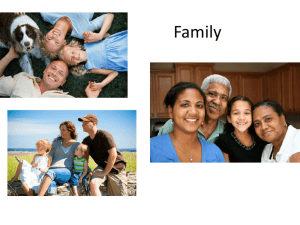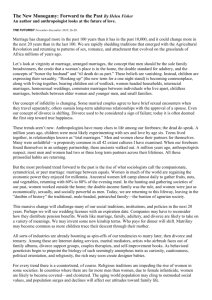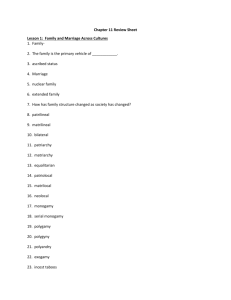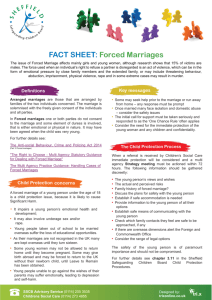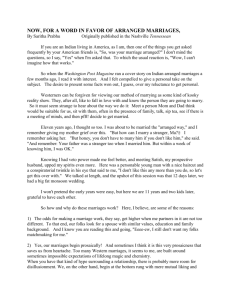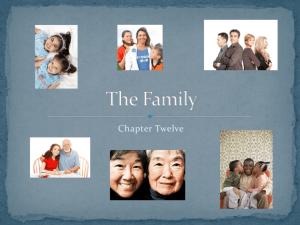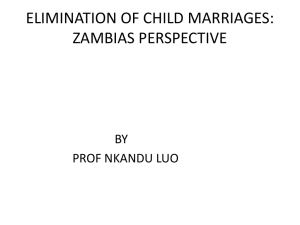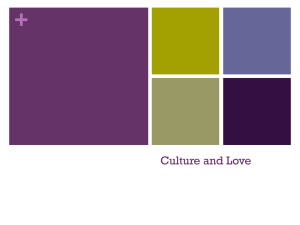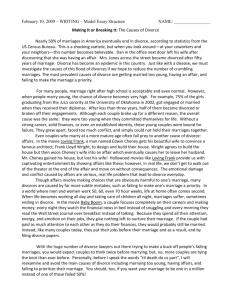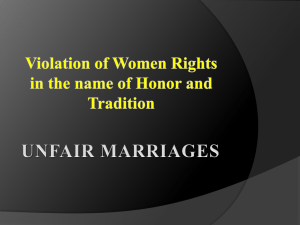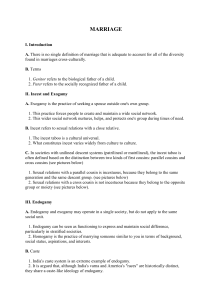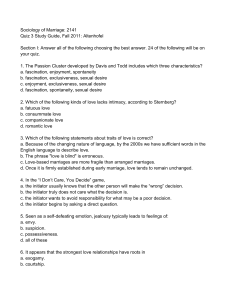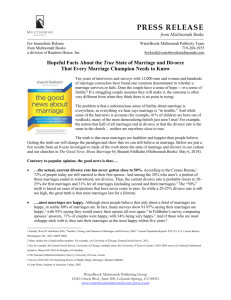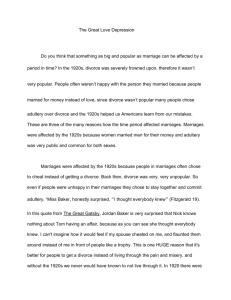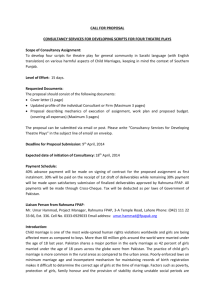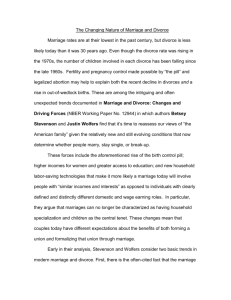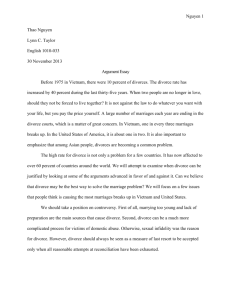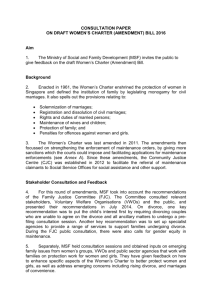family and marriage in transition
advertisement
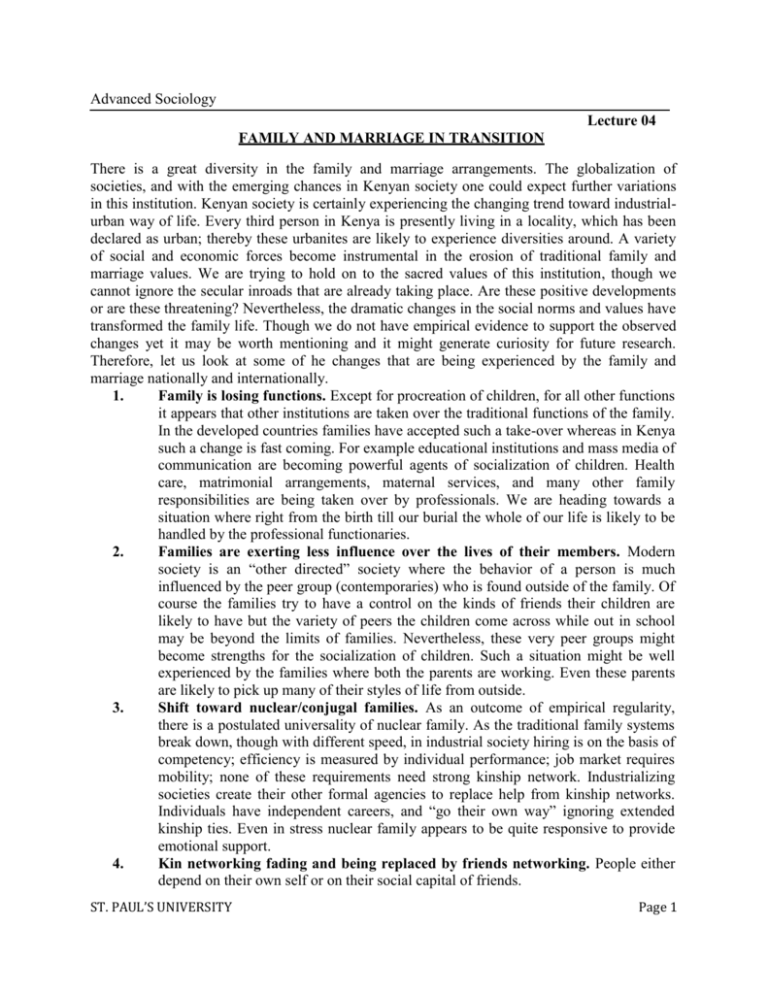
Advanced Sociology Lecture 04 FAMILY AND MARRIAGE IN TRANSITION There is a great diversity in the family and marriage arrangements. The globalization of societies, and with the emerging chances in Kenyan society one could expect further variations in this institution. Kenyan society is certainly experiencing the changing trend toward industrialurban way of life. Every third person in Kenya is presently living in a locality, which has been declared as urban; thereby these urbanites are likely to experience diversities around. A variety of social and economic forces become instrumental in the erosion of traditional family and marriage values. We are trying to hold on to the sacred values of this institution, though we cannot ignore the secular inroads that are already taking place. Are these positive developments or are these threatening? Nevertheless, the dramatic changes in the social norms and values have transformed the family life. Though we do not have empirical evidence to support the observed changes yet it may be worth mentioning and it might generate curiosity for future research. Therefore, let us look at some of he changes that are being experienced by the family and marriage nationally and internationally. 1. Family is losing functions. Except for procreation of children, for all other functions it appears that other institutions are taken over the traditional functions of the family. In the developed countries families have accepted such a take-over whereas in Kenya such a change is fast coming. For example educational institutions and mass media of communication are becoming powerful agents of socialization of children. Health care, matrimonial arrangements, maternal services, and many other family responsibilities are being taken over by professionals. We are heading towards a situation where right from the birth till our burial the whole of our life is likely to be handled by the professional functionaries. 2. Families are exerting less influence over the lives of their members. Modern society is an “other directed” society where the behavior of a person is much influenced by the peer group (contemporaries) who is found outside of the family. Of course the families try to have a control on the kinds of friends their children are likely to have but the variety of peers the children come across while out in school may be beyond the limits of families. Nevertheless, these very peer groups might become strengths for the socialization of children. Such a situation might be well experienced by the families where both the parents are working. Even these parents are likely to pick up many of their styles of life from outside. 3. Shift toward nuclear/conjugal families. As an outcome of empirical regularity, there is a postulated universality of nuclear family. As the traditional family systems break down, though with different speed, in industrial society hiring is on the basis of competency; efficiency is measured by individual performance; job market requires mobility; none of these requirements need strong kinship network. Industrializing societies create their other formal agencies to replace help from kinship networks. Individuals have independent careers, and “go their own way” ignoring extended kinship ties. Even in stress nuclear family appears to be quite responsive to provide emotional support. 4. Kin networking fading and being replaced by friends networking. People either depend on their own self or on their social capital of friends. ST. PAUL’S UNIVERSITY Page 1 5. 6. 8. 9. 10. 11. 12. Declining size of families. With the societies moving towards modernization, there is a decline in the fertility of women. In Kenya from 6.3 children per woman in the 1970 we have come down to around 4 children per woman in 2004. Some of the reasons could be: the rise in age at first marriage; decline in infant mortality (140/1000 live births in 1970 to around 85/1000 in 2004); increasing number of women especially older women not desiring to get pregnant and younger wanting to space births; decline in desired family size; use of contraceptives. All these reasons may have strong link with the education of families. The rise of symmetrical families. There is an increase in dual earner families. One could find a trend in the families where both husband and wife are working and sharing the household work. Or if the wife is busy in the second shift at home, the husband might also be having a second job. Patriarchy on the decline. As the proportion of dual earners marriages continues to increase, women’s financial dependence on their husbands declines, leading to a decline in patriarchy. In the changing scenario instead of centralized decision making, families are moving towards shared decision making. Hence patriarchy gives way to egalitarianism. Arranged marriages are being replaced by ‘marriages of inclination’. Traditionally marriages of children were arranged by their parents, but now youngsters are trying to exert their personal choices in their matrimony. In the Western societies alternative marriage arrangements are on the increase. For example common law marriages (a marriage without marriage license) are on the increase. Women empowerment. There is a changing status of women due to increase in literacy and in the levels of literacy, financial independence, and in their decision making power. Divorce rates have been increasing. There could be many reasons like: • Individualism on the increase. People are looking for personal happiness. • Romantic love often subsides. Marriages of inclination are relatively more lnerable to conflict and divorce. • Women now are less dependent on men. • Many of today’s marriages are stressful. Since both husband and wife are working, their jobs consume most of their time and energy, then, if they have to raise the children, there is not enough time and energy left for each other. • Presently divorce is becoming more socially accepted. It is no more considered a stigma. • From legal stand point, divorce is becoming easier to obtain. Couple may not have to resort to mud throwing on each other, so the couple decides and the court allows. Lone old parent families on the increase. The institution of family as the shelter for the aged is gradually eroding. As the children grow up they, in search of their livelihood, head for new destinations leaving their senior citizens in the empty nest. Here one could find a big gap between the real and ideal value about caring the old people. Even the alternatives like the community support, nursing homes have not emerged. The plight of single women, widows, and the sick persons is high. We have ST. PAUL’S UNIVERSITY Page 2 13. 14. 7. added years to life but not life to added years. Awareness of family violence has increased. May be in the changing situation family violence has also increased. The number of elderly marriages and remarriages is increasing. The people deciding to get married in their old age don’t feel shy anymore. Rather than leading a lonely life in case of their being divorced or widowed, the elderly decide to get married. Since divorce does not appear to be a stigma, therefore, divorcees don’t feel hesitant to remarry. Monogamy presumably becoming universal. There might be an increase in remarriages but the individuals are restricting themselves to one union at a time. So people marry, divorce, and remarry, but at time a person is married to only one partner, which may be called as serial monogamy. ST. PAUL’S UNIVERSITY Page 3
